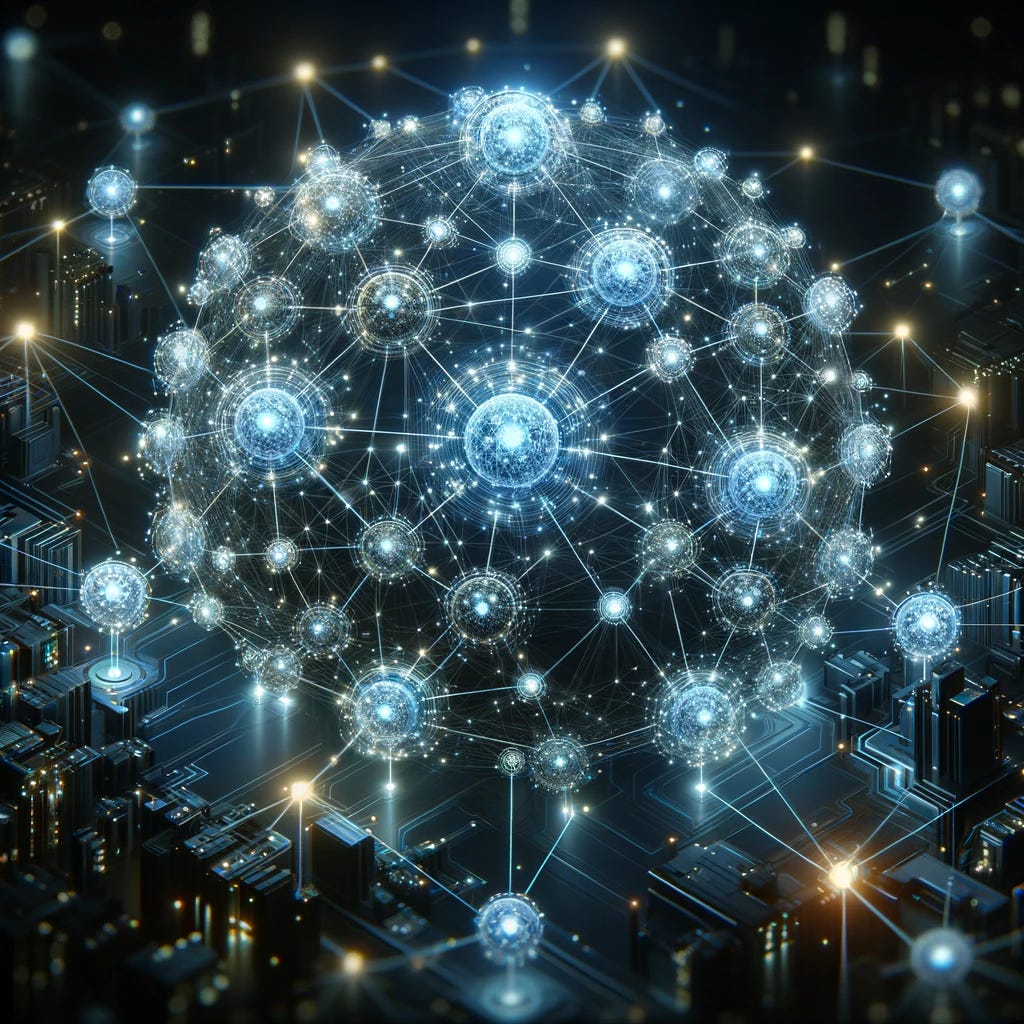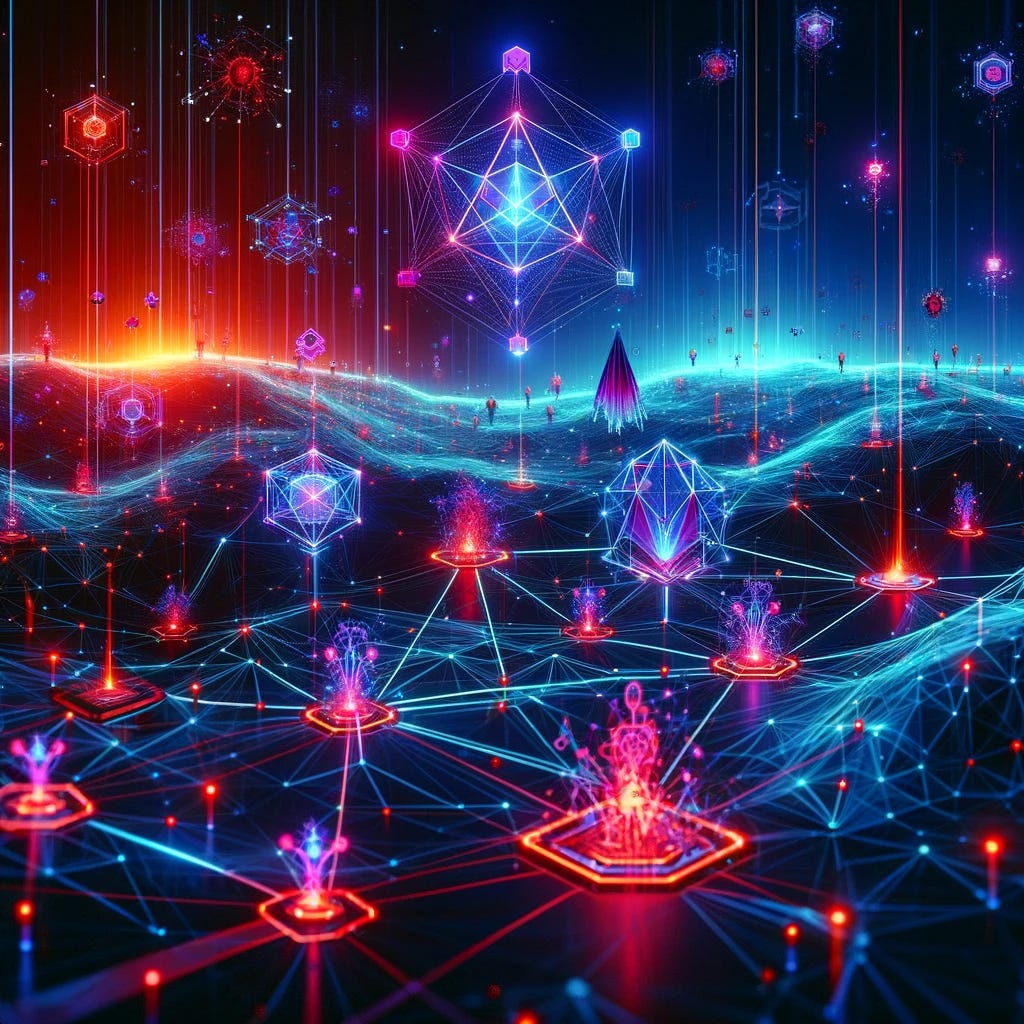Introduction
In the vast digital ecosystem, where threats evolve at breakneck speed, a revolutionary approach is making waves: swarm learning. This isn’t your ordinary tech trend; it’s a paradigm shift inspired by nature itself. Just like flocks of birds move in harmony or schools of fish pivot to evade predators, swarm learning harnesses the power of collective intelligence to fortify our digital defenses.
Imagine a network of computers learning from each other in real-time, sharing insights and strategies without a central command, each node contributing to a more resilient and adaptive security system. This is the essence of swarm learning, and it’s reshaping the landscape of cybersecurity in ways we’re just beginning to understand.

At the vanguard of this movement is Armur AI, a trailblazer that’s leveraging the principles of swarm learning to outsmart cyber threats. With Armur AI, cybersecurity isn’t just about reacting to attacks; it’s about anticipating them, adapting to them, and outmaneuvering them with the collective wisdom of the swarm.
In this blog, we’ll dive into the world of swarm learning, exploring its foundations, its applications in cybersecurity, and how Armur AI is using this innovative approach to stay one step ahead of cyber adversaries. Get ready to embark on a journey into the future of cybersecurity, where collective intelligence isn’t just a concept; it’s the key to safeguarding our digital world.
Understanding Swarm Learning
Imagine a world where every individual decision isn’t just a solitary drop in the ocean but a vital part of a massive, intelligent wave. This is the essence of swarm learning—a groundbreaking approach that draws inspiration from nature’s most fascinating phenomena: the collective behaviors of birds, bees, and fish. But how does this translate into the realm of cybersecurity? Let’s dive into the technicalities and marvel at the potential.

Conceptual Overview: Swarm learning is a paradigm shift in machine learning, emphasizing decentralized, collaborative decision-making processes. Unlike traditional models that rely on centralized data processing, swarm learning allows individual nodes in a network to learn from localized data inputs and share insights without needing to pool all data in a single location. This method not only enhances privacy and data security but also scales learning capabilities across vast networks.
Technical Underpinnings: At its core, swarm learning relies on sophisticated algorithms that enable a form of communication akin to the pheromone trails of ants or the intricate dances of bees. Each node in the network operates independently, processing local data and making decisions based on both its findings and the aggregated knowledge received from its peers. This decentralized approach is facilitated by blockchain technology, ensuring transparency, security, and integrity in the exchange of insights across the swarm.
-
Edge Computing: Swarm learning leverages edge computing, where data processing occurs on the periphery of the network, closer to where data is generated. This reduces latency, minimizes bandwidth usage, and accelerates decision-making processes.
-
Blockchain and Smart Contracts: To ensure trust and secure communication among nodes, swarm learning utilizes blockchain and smart contracts. These technologies provide a tamper-proof ledger of transactions and automated execution of agreements based on predefined conditions, crucial for maintaining integrity in decentralized networks.
Advantages Over Traditional Models: The decentralized nature of swarm learning offers several distinct advantages over conventional centralized machine learning frameworks:
-
Resilience to Data Breaches: By avoiding the centralization of data, swarm learning inherently reduces the risk of massive data breaches, a common vulnerability in traditional systems.
-
Scalability: Swarm learning can seamlessly scale with the addition of new nodes, making it ideal for growing networks without significant overhauls in infrastructure.
-
Efficiency and Speed: Localized data processing and decision-making significantly speed up learning and response times, crucial for real-time threat detection and mitigation in cybersecurity.
Swarm learning represents a monumental leap in how we conceptualize and implement machine learning, especially in the cybersecurity domain. Its ability to harness the collective intelligence of decentralized networks while maintaining privacy and security is not just innovative; it’s transformative.
Swarm Learning in Cybersecurity
As we venture deeper into the digital age, the cyber threat landscape evolves with increasing complexity and sophistication. Traditional defense mechanisms often struggle to keep pace with these rapid changes, highlighting the urgent need for innovative solutions. Enter swarm learning, a beacon of hope in this relentless storm. Let’s explore how this paradigm is fortifying our digital ramparts.

The Cyber Threat Landscape: The battleground of cybersecurity is fraught with a variety of ever-evolving threats. From sophisticated phishing scams to complex ransomware attacks, the arsenal of cyber adversaries grows more formidable by the day. In this context, the static, centralized nature of traditional cybersecurity measures often falls short, unable to adapt quickly enough to the dynamic nature of modern cyber threats.
Swarm Learning to the Rescue: Swarm learning, with its decentralized, collaborative approach, offers a potent solution to these challenges. By leveraging the collective intelligence of a network, cybersecurity systems can dynamically learn from each encounter with a threat, continually updating their defenses in real time.
-
Dynamic Threat Detection: Swarm learning enables a network of sensors or nodes to share insights about potential threats in real-time, vastly improving the speed and accuracy of threat detection. This collective vigilance ensures that when one node encounters a new threat, the entire network becomes instantly aware and prepared.
-
Decentralized Decision-Making: In the face of an attack, swift decision-making is crucial. Swarm learning empowers individual nodes to make informed decisions on the fly, based on shared intelligence. This not only accelerates response times but also distributes the decision-making process, making it harder for attackers to predict and counteract defense strategies.
-
Resilient Network Defense: The decentralized nature of swarm learning makes cybersecurity defenses more resilient to attacks. Since there’s no single point of failure, compromising one part of the system doesn’t bring down the whole network. This resilience is critical in maintaining operations and ensuring continuity in the face of cyber assaults.
Real-World Applications: Swarm learning isn’t just theoretical; it’s already making waves in the cybersecurity realm. For instance, distributed denial-of-service (DDoS) defense mechanisms powered by swarm learning can quickly isolate and mitigate attacks by sharing real-time data across the network. Similarly, intrusion detection systems (IDS) utilize swarm intelligence to identify and neutralize threats more efficiently, learning from each attack to bolster their defenses.
The application of swarm learning in cybersecurity marks a significant shift from reactive to proactive defense strategies. By harnessing the collective intelligence of decentralized networks, cybersecurity professionals are not just responding to threats but anticipating them, staying one step ahead of cybercriminals.
Armur AI: Pioneering Swarm Learning in Cybersecurity
In the vanguard of the cybersecurity renaissance, Armur AI emerges as a beacon of innovation, steering the ship with the cutting-edge technology of swarm learning. This section delves into how Armur AI is not just adopting swarm learning but pioneering its application to outmaneuver cyber threats with unprecedented precision and agility.

Introduction to Armur AI: Armur AI stands at the confluence of advanced machine learning techniques and cybersecurity, dedicating its prowess to harnessing the collective intelligence of swarm learning. Their mission? To fortify digital defenses in a manner that’s not only reactive but predictive, staying several steps ahead of cyber adversaries.
How Armur AI Uses Swarm Learning: Armur AI leverages swarm learning to create a decentralized network of threat detection and response mechanisms. This approach mirrors the collaborative efforts seen in natural swarms, where each unit contributes to the collective knowledge and defense capabilities of the whole.
-
Predictive Analytics: By analyzing data from myriad points across the network, Armur AI’s systems can predict and identify potential threats before they materialize. This preemptive capability is akin to a global immune system, constantly scanning for anomalies and neutralizing them.
-
Automated Threat Response: The moment a threat is detected, Armur AI’s decentralized nodes can autonomously respond, isolate, and neutralize the threat. This rapid response mechanism significantly reduces the time from detection to resolution, a critical factor in minimizing damage.
-
Collective Intelligence-Driven Security Protocols: Armur AI’s protocols evolve in real-time, learning from each interaction and threat. This continuous improvement cycle ensures that the system’s defenses become increasingly sophisticated, adapting to new threats as they arise.
Success Stories: Armur AI’s approach has already yielded significant victories in the cyber arena. One notable case involved thwarting an advanced persistent threat (APT) that had eluded conventional detection methods. Through the collective intelligence of its swarm learning network, Armur AI identified subtle, anomalous patterns that unveiled the APT, enabling a swift and decisive response that protected critical infrastructure.
Challenges and Overcoming Them: Adopting such a groundbreaking approach does not come without its challenges. Integrating swarm learning into existing cybersecurity frameworks requires not just technological adjustments but a paradigm shift in how threats are perceived and managed. Armur AI has navigated these waters by fostering a culture of innovation and resilience, ensuring that its solutions remain at the cutting edge of cybersecurity technology.
The Future of Cybersecurity with Swarm Learning
As we stand on the brink of a new dawn in digital defense, the future of cybersecurity looks promising, thanks to the advent of swarm learning. This approach, inspired by the natural world, is not just an incremental improvement but a revolutionary leap forward. Here’s what we can anticipate as swarm learning continues to evolve and integrate with cybersecurity strategies:

Innovations on the Horizon: The integration of swarm learning into cybersecurity is expected to usher in a new era of dynamic, self-healing digital ecosystems. Imagine networks that don’t just defend against attacks but anticipate them, adapt to them, and even learn from them in real-time. This could lead to the development of cybersecurity systems that are as adaptable and resilient as the natural swarms that inspire them.
Challenges and Opportunities: The path to fully realizing the potential of swarm learning in cybersecurity is fraught with challenges. Issues such as ensuring data privacy, managing the complexity of decentralized networks, and overcoming resistance to new technologies must be addressed. However, these challenges also present opportunities for innovation, collaboration, and the development of new standards and protocols that can make the digital world safer for everyone.
Ethical Considerations: As with any powerful technology, the ethical implications of swarm learning in cybersecurity must be carefully considered. Questions about accountability, the potential for misuse, and the impact on privacy and individual rights are paramount. The cybersecurity community must engage in ongoing dialogue to ensure that the benefits of swarm learning are realized without compromising ethical standards.
Conclusion: Embracing Collective Intelligence for Cybersecurity
The journey through the world of swarm learning and its application in cybersecurity has been both enlightening and inspiring. Armur AI’s pioneering work in this field represents just the beginning of what’s possible when we harness the power of collective intelligence to protect our digital lives.
As we look to the future, it’s clear that the principles of swarm learning—decentralization, collaboration, and adaptability—will play a crucial role in shaping cybersecurity strategies. By embracing these concepts, we can create a more resilient, responsive, and intelligent defense against the ever-evolving threats of the digital age.
The promise of swarm learning in cybersecurity is not just in its ability to defend against attacks but in its potential to transform our entire approach to digital security. As we continue to explore and expand the boundaries of this exciting field, the possibilities are as vast as the digital universe itself.
Let’s not just adapt to the future; let’s shape it by embracing the power of swarm learning and the innovative spirit of pioneers like Armur AI. Together, we can forge a safer, more secure digital world for generations to come.
Thanks for reading Armur’s Cybersecurity Blog! Subscribe for free to receive new posts and support my work.



